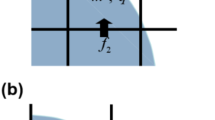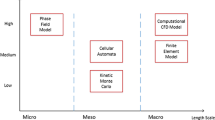Abstract
A one-dimensional conduction heat transfer model has been proposed to study the melting and solidification of phase change material (PCM) inside an annulus. Here, the phase change process is divided into two main sub-processes such as melting and solidification sub-process. Subsequently, each sub-process is analyzed for various temporal regimes. The temporal regimes include completely solid, partially molten and completely molten for melting sub-process and in reverse order for solidification sub-process. Later on, the solution for temperature distribution for each temporal regime is obtained either by employing Variational formulation or using a method of quasi-steady state. The solution of each temporal regime is united to provide a closed form solution for temperature distribution for the sub-process. Present model exhibits good agreement with the existing experimental data. The results indicate that melt duration can be increased by increasing the thickness of PCM in an annulus. It is also found observed that for any thermal storage unit there exists a particular percentage of TCE-PCM distribution through which maximum melt duration can be achieved.












Similar content being viewed by others
Abbreviations
- c s, c l :
-
Solid and liquid specific heat, J/kg-K
- h :
-
Outside heat transfer coefficient, W/m2-K
- r 1, r 2 :
-
Inner and outer radii of cylinder, m
- k s, k l :
-
Solid and liquid thermal conductivity, W/m-K
- L p :
-
Latent heat of PCM, J/kg
- q ″ :
-
Heat flux, W/m2
- T :
-
Temperature, 0C
- T ∞ :
-
Ambient temperature, 0C
- T i :
-
Initial temperature of PCM, 0C
- T m :
-
Melting temperature, 0C
- T s, T l :
-
Solid and liquid temperature, 0C
- ΔT :
-
Tm − T∞, 0C
- t :
-
Time, s
- t 0 :
-
Thermal penetration time, s
- t m :
-
Time for start of melting, s
- t ′ :
-
Time for complete melting, s
- t ″ :
-
Time for complete solidification
- t s :
-
Time for start of solidification
- ε(t):
-
Thermal penetration depth, m
- R (t):
-
Melt interface location, m
- Bi s, Bi l :
-
\( \frac{h{r}_2}{k_s},\frac{h{r}_2}{k_s} \) (Biot number)
- Ste s, Ste l :
-
\( \frac{c_s\varDelta T}{L_p},\frac{c_l\varDelta T}{L_p} \)(Stefan’s number)
- r:
-
coordinate
- α s, α l :
-
Solid and liquid thermal diffusivity, m2/s
- β :
-
\( \frac{r_1}{r_2} \)
- γ :
-
\( \frac{r_2}{R(t)} \)
- φ s :
-
\( \frac{k_s\varDelta T}{q^{\prime \prime }} \), m
- φ l :
-
\( \frac{k_l\varDelta T}{q^{\prime \prime }} \), m
- ρ :
-
Density of PCM, kg/m3
- s :
-
Solid
- l :
-
Liquid
- p :
-
Phase change material
References
Zalba B, Marin JM, Cabeza LF, Mehling H (2003) Review on thermal energy storage with phase change materials, heat transfer analysis and applications. Appl Therm Eng 23(3):251–283
Ling Z, Zhang Z, Shi G, Fang X, Wang L, Zhao X, Fang Y, Xu T, Wang S, Liu X (2014) Review on thermal management system using phase change materials for electronic components, li-ion batteries and photovoltaic modules. Renew Sust Energ Rev 31:427–438
Sahoo S, Das M, Rath P (2016) Application of TCE-PCM based heat sinks for cooling of electronic components: a review. Renew Sust Energ Rev 59:550–582
Rao Z, Wang S (2011) A review of power battery thermal energy management. Renew Sust Energ Rev 15(9):4554–4571
Duan X, Naterer GF (2010) Heat transfer in phase change materials for thermal management of electric vehicle battery modules. Int J Heat Mass Transf 53:5176–5182
Ramandi MY, Dincer I, Naterer GF (2011) Heat transfer and thermal management of electric vehicle batteries with phase change materials. Heat Mass Transf 47:777–788
Kim GH, Gonder J, Lustbader J, Pesaran A (2007) Thermal management of batteries in advanced vehicles using phase-change materials. 23rd International Electric vehicles Symposium and Exposition, Anaheim
Pal D, Joshi YK (2001) Melting in a side heated tall enclosure by a uniformly dissipating heat source. Int J Heat Mass Transf 44:375–387
Saha SK, Srinivasn K, Dutta P (2008) Studies on optimum distribution of fins in heat sinks filled with phase change materials. J Heat Transf 130:034505-1–034505-5
Baby R, Balaji C (2012) Experimental investigations on phase change material based finned heat sinks for electronic cooling. Int J Heat Mass Transf 55:1642–1649
Gharbi S, Harmand S, Jabrallah SB (2015) Experimental comparison between different configurations of PCM based heat sinks for cooling electronic components. App Therm Eng 87:454–462
Liu Z, Sun X, Ma C (2005) Experimental investigations on the characteristics of melting process of stearic acid in an annulus and its thermal conductivity enhancement by fins. Energy Convers Manag 46:959–969
Liu Z, Sun X, Ma C (2005) Experimental investigations on the characteristics of solidification process of stearic acid in an annulus and its thermal conductivity enhancement. Energy Convers Manag 46:971–984
Lu TJ (2000) Thermal management of high power electronics with phase change cooling. Int J Heat Mass Transf 43:2245–2256
Chakraborty S, Dutta P (2003) Analytical solution for heat transfer during cyclic melting and freezing of phase change material used in electronic of electrical packaging. J Electron Pack 125:126–133
Laouadi A, Lacroix M (1999) Thermal performance of a heat energy storage ventilated panel for electronic load management. Int J Heat Mass Transf 42:275–286
Jiji LM, Gaye S (2006) Analysis of solidification and melting of PCM with energy generation. Appl Therm Eng 26:568–575
Kalaiselvam S, Veerappan M, Aaron AA, Iniyan S (2008) Experimental and analytical investigation of solidification and melting characteristics of PCMs inside cylindrical encapsulation. Int J Therm Sci 47:858–874
Saha SK, Dutta P (2015) Performance analysis of heat sinks with phase change materials subjected to transient and cyclic heating. Heat Trans Eng 36(16):1349–1359
Kalaiselvam S, Parameshwaran R, Harikrishnan S (2012) Analytical and experimental investigations of nano particles embedded phase change materials for cooling applications in modern buildings. Renew Energy 39:375–387
Mosaffa AH, Talati F, Rosen MA, Tabirizi HB (2012) Approximate analytical model for PCM solidification in a rectangular finned container with convective cooling boundaries. Int Comm Heat Mass Trans 39:318–324
Shamberger PJ (2016) Cooling capacity figure of merit for phase change materials. J Heat Transf 138:024502-1–024502-8
Apraci VS (1996) Conduction heat transfer. Addison-Wesley, Reading
Acknowledgements
The financial support provided by Department of Science and Technology (DST), India under the project grant DST/TMD/MES/2 k17/65 (G) is gratefully acknowledged. The first author acknowledges the financial support by DST, India under DST-INSPIRE Fellowship program (IF170534).
Author information
Authors and Affiliations
Corresponding author
Additional information
Publisher’s Note
Springer Nature remains neutral with regard to jurisdictional claims in published maps and institutional affiliations.
Research highlights
• Analytical model is proposed for melting and solidification of phase change material (PCM) in an annulus.
• The phase change process of PCM is divided into three temporal regimes; namely, completely solid, partially molten and completely molten.
• Closed form expressions for the temperature distribution is obtained as a function of various modeling parameters.
• Present prediction exhibits good agreement with the test data.
Rights and permissions
About this article
Cite this article
Kothari, R., Sahu, S.K. & Kundalwal, S.I. Comprehensive analysis of melting and solidification of a phase change material in an annulus. Heat Mass Transfer 55, 769–790 (2019). https://doi.org/10.1007/s00231-018-2453-9
Received:
Accepted:
Published:
Issue Date:
DOI: https://doi.org/10.1007/s00231-018-2453-9




